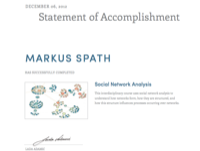Coursera: Social Network Analysis

6. Dezember 2012
Social Network Analysis
Instructor: Lada Adamic, University of Michigan
Zeitraum: Dezember 2012
Status: habe ich gemacht, inkl. Exams und Zertifikat
Anmerkung: fand ich ganz gut.
Course Syllabus
Week 1: What are networks and what use is it to study them?
Concepts: nodes, edges, adjacency matrix, one and two-mode networks, node degree
Activity: Upload a social network (e.g. your Facebook social network into Gephi and visualize it ).
Week 2: Random network models: Erdos-Renyi and Barabasi-Albert
Concepts: connected components, giant component, average shortest path, diameter, breadth-first search, preferential attachment
Activities: Create random networks, calculate component distribution, average shortest path, evaluate impact of structure on ability of information to diffuse
Week 3: Network centrality
Concepts: betweenness, closeness, eigenvector centrality (+ PageRank), network centralization
Activities: calculate and interpret node centrality for real-world networks (your Facebook graph, the Enron corporate email network, Twitter networks, etc.)
Week 4: Community
Concepts: clustering, community structure, modularity, overlapping communities
Activities: detect and interpret disjoint and overlapping communities in a variety of networks (scientific collaborations, political blogs, cooking ingredients, etc.)
Week 5: Small world network models, optimization, strategic network formation and search
Concepts: small worlds, geographic networks, decentralized search
Activity: Evaluate whether several real-world networks exhibit small world properties, simulate decentralized search on different topologies, evaluate effect of small-world topology on information diffusion.
Week 6: Contagion, opinion formation, coordination and cooperation
Concepts: simple contagion, threshold models, opinion formation
Activity: Evaluate via simulation the impact of network structure on the above processes
Week 7: Cool and unusual applications of SNA
Hidalgo et al. : Predicting economic development using product space networks (which countries produce which products)
Ahn et al., and Teng et al.: Learning about cooking from ingredient and flavor networks
Lusseau et al.: Social networks of dolphins
Activity: hands-on exploration of these networks using concepts learned earlier in the course
Week 8: SNA and online social networks
Concepts: how services such as Facebook, LinkedIn, Twitter, CouchSurfing, etc. are using SNA to understand their users and improve their functionality
Activity: read recent research by and based on these services and learn how SNA concepts were applied